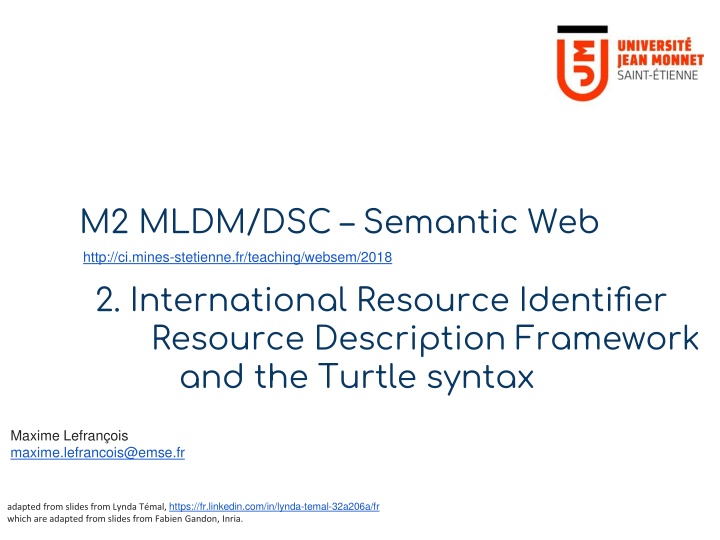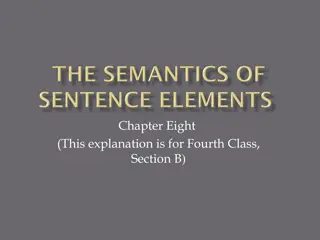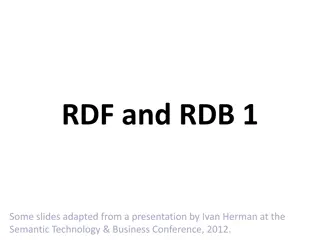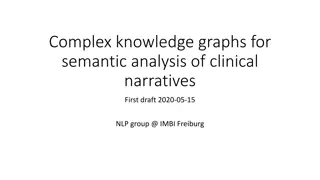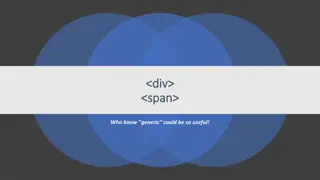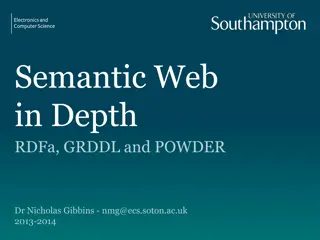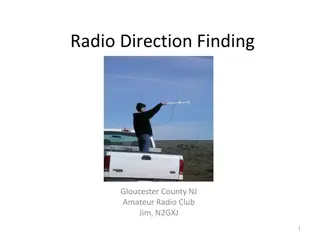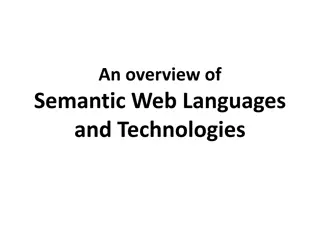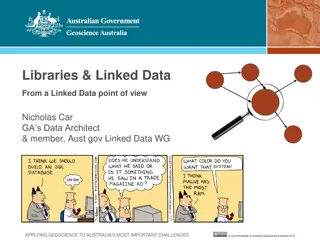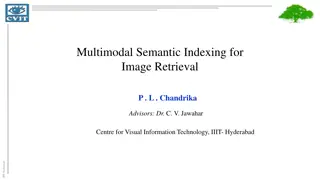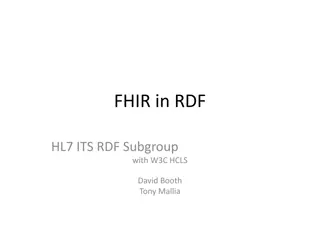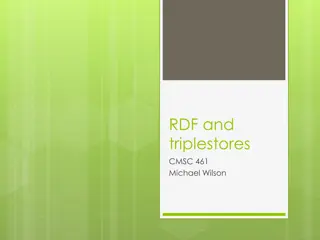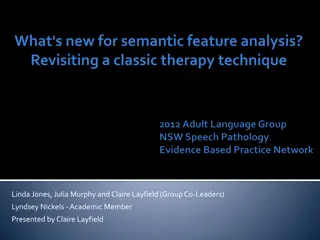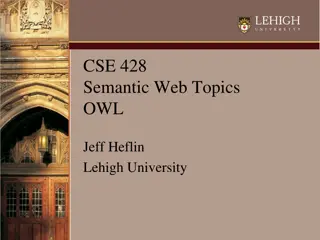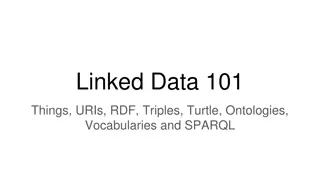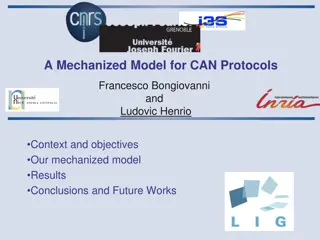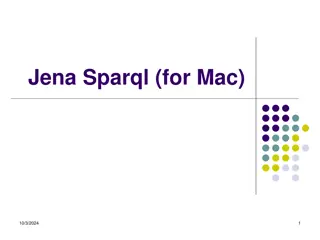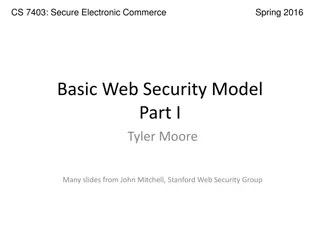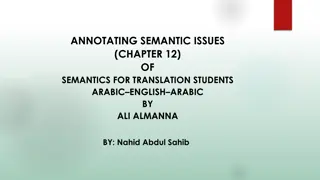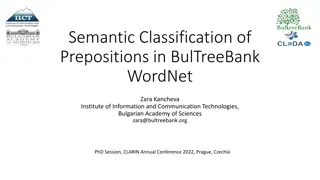Overview of Semantic Web and RDF Concepts
This content delves into concepts related to Semantic Web, RDF (Resource Description Framework), and formalisms of Trust Reasoning Representation. It covers topics such as RDF resource description, triple models, machine interpretation challenges, and the role of key figures like Timothy John Berners-Lee in the development of the World Wide Web.
Uploaded on Sep 06, 2024 | 0 Views
Download Presentation

Please find below an Image/Link to download the presentation.
The content on the website is provided AS IS for your information and personal use only. It may not be sold, licensed, or shared on other websites without obtaining consent from the author.If you encounter any issues during the download, it is possible that the publisher has removed the file from their server.
You are allowed to download the files provided on this website for personal or commercial use, subject to the condition that they are used lawfully. All files are the property of their respective owners.
The content on the website is provided AS IS for your information and personal use only. It may not be sold, licensed, or shared on other websites without obtaining consent from the author.
E N D
Presentation Transcript
M2 MLDM/DSC Semantic Web http://ci.mines-stetienne.fr/teaching/websem/2018 2. International Resource Identifier Resource Description Framework and the Turtle syntax Maxime Lefran ois maxime.lefrancois@emse.fr adapted from slides from Lynda T mal, https://fr.linkedin.com/in/lynda-temal-32a206a/fr which are adapted from slides from Fabien Gandon, Inria.
Semantic Web Formalisms Trust Reasoning Representation 2
Semantic Web Formalisms Trust Reasoning 3
RDF Resource: company, building, sensor, temperature, unit, Description: attributes, quality, and relations between ressources Framework: model, languages and syntaxes for these descriptions 4
RDF : a triple model ( subject , predicate, object ) Structure of a simple sentence Lynda works_at Engie ( subject , verb, object) 5
RDF : A set of triples = a RDF graph 6
This cannot be interpreted by a machine Timothy John Berners-Lee, Born June 8th 1955 in Londres. Is the principal inventor of the World Wide Web. President of the World Wide Web Consortium (W3C), which he founded. Author of the book a Framework for Web Science. 7
Identification : Ressources & Relations Timothy John Berners-Lee, Born June 8th 1955 in Londres. Is the principal inventor of the World Wide Web. President of the World Wide Web Consortium (W3C), which he founded. Author of the book a Framework for Web Science. 8
Simple sentence TimBL has date of birth 1955-06-08. TimBL has place of birth London. TimBL is inventor of WWW. TimBL is director of W3C. TimBL is founder of W3C. TimBL is author of Framework for Web Sience 9
RDF Triples: interpretable by the machine (TimBL, dateOfBirth, 1955-06-08) (TimBL, placeOfBirth, London) (TimBL, isInventorOf, WWW) (TimBL, isDirectorOf, W3C) (TimBL, isFounderOf, W3C) (TimBL, isAuthorOf, Web_Science) (Sujet, predicat, Objet) 10
RDF triples can be represented by a oriented graph (node, arc, node) 11
1955-06-08 dateOfBirth TimBL isFounderOf W3C 12
Rules to write RDF triples The subject is always a resource (never a literal) The predicates are binary relations identified by URIs The object is a resource or a literal 13
URL: Universal Resource Locator URN: Universal Resource Name urn:isbn:0-395-36341-1 (r f. RFC 3187) urn:uuid:f81d4fae-7dec-11d0-a765-00a0c91e6bf6 (r f. RFC 4122) urn:ietf:rfc:2141 (r f. RFC 2648) See list https://www.iana.org/assignments/urn-namespaces/urn-namespaces.xhtml 15
1955-06-08 dateOfBirth TimBL isFounderOf W3C 17
1955-06-08 http://dbpedia.org/ontology/birthDate http://dbpedia.org/resource/Tim_Berners-Lee http://dbpedia.org/property/founder http://www.w3.org 18
"1955-06-08"^^<http://www.w3.org/2001/XMLSchema#> http://dbpedia.org/ontology/birthDate http://dbpedia.org/resource/Tim_Berners-Lee http://dbpedia.org/property/founder http://www.w3.org 19
(one of ~) RDF syntaxes - N-Triple <http://dbpedia.org/resource/Tim_Berners-Lee> <http://purl.org/dc/terms/creator> <http://www.w3.org>. <http://dbpedia.org/resource/Tim_Berners-Lee> <http://dbpedia.org/property/dateOfBirth> 1955-06-08 ^^<http://www.w3.org/2001/XMLSchema#date>. <http://dbpedia.org/resource/Tim_Berners-Lee> <http://dbpedia.org/property/placeOfBirth> <http://dbpedia.org/resource/London>. <http://dbpedia.org/resource/London> <http://dbpedia.org/property/isPartOf> <http://dbpedia.org/resource/England>. 20
(one of ~) RDF syntaxes -Turtle Syntactic sugar ++ 21
Turtle prefixes and bases <http://example.org/instances/appartement418> <http://www.w3.org/1999/02/22-rdf-syntax-ns#type> <http://example.org/vocabulary/T2> . = @Prefix rdf: <http://www.w3.org/1999/02/22-rdf-syntax-ns#>. @Prefix : <http://example.org/vocabulary/> . @Base <http://example.org/instances/> . <appartement418> rdf:type :T2 . 22
Turtle prefixes and bases @Prefix rdf: <http://www.w3.org/1999/02/22-rdf-syntax-ns#>. @Prefix dbp: <http://dbpedia.org/property/>. @Prefix dbr: <http://dbpedia.org/resource/>. @Prefix dc: <http://purl.org/dc/terms/>. @Prefix xsd: <http://www.w3.org/2001/XMLSchema#>. dbr:Tim_Berners-Lee rdf:type dbo:Scientist . dbr:Tim_Berners-Lee dc:creator <http://www.w3.org> . dbr:Tim_Berners-Lee dbp:dateOfBirth 1955-06-08 ^^xsd:date . dbr:Tim_Berners-Lee dbp:placeOfBirth dbr:London . dbr:Tim_Berners-Lee dbp:placeOfBirth dbr:England . dbr:London dbp:isPartOf dbr:England . 23
Separators . - ; @Prefix rdf: <http://www.w3.org/1999/02/22-rdf-syntax-ns#>. @Prefix dbp: <http://dbpedia.org/property/>. @Prefix dbr: <http://dbpedia.org/resource/>. @Prefix dc: <http://purl.org/dc/terms/>. @Prefix xsd: <http://www.w3.org/2001/XMLSchema#>. dbr:Tim_Berners-Lee rdf:type dbo:Scientist ; dc:creator <http://www.w3.org> ; dbp:dateOfBirth 1955-06-08 ^^xsd:date ; dbp:placeOfBirth dbr:London ; dbp:placeOfBirth dbr:England . dbr:London dbp:isPartOf dbr:England . 24
Separators . - ; - , @Prefix rdf: <http://www.w3.org/1999/02/22-rdf-syntax-ns#>. @Prefix dbp: <http://dbpedia.org/property/>. @Prefix dbr: <http://dbpedia.org/resource/>. @Prefix dc: <http://purl.org/dc/terms/>. @Prefix xsd: <http://www.w3.org/2001/XMLSchema#>. dbr:Tim_Berners-Lee rdf:type dbo:Scientist ; dc:creator <http://www.w3.org> ; dbp:dateOfBirth 1955-06-08 ^^xsd:date ; dbp:placeOfBirth dbr:London , dbr:England . dbr:London dbp:isPartOf dbr:England . 25
Check out these tools: http://prefix.cc/ https://perfectkb.github.io/yate/ 26
How to say: There exists something that with RDF ? Anonymous nodes (blank node) 27
How to say: There exists something that with RDF ? Anonymous nodes (blank node) dbr:Tim_Berners-Lee dbo:marriedTo _:bnode1 . _:bnode1 foaf:firstName "Nancy" ; foaf:lastName "Carlson" . 28
How to say: There exists something that with RDF ? Anonymous nodes (blank node) dbr:Tim_Berners-Lee dbo:marriedTo [ foaf:firstName "Nancy" ; foaf:lastName "Carlson" ] . @Prefix foaf: <http://xmlns.com/foaf/0.1/> . # Someone knows someone else, who has the name "Bob". [ ] foaf:knows [ foaf:name "Bob" ] . 29
How to represent a closed list in RDF ? Web_Science has for chapter: 1. chap1 2. chap2 3. chap3 30
How to represent a closed list in RDF ? rdf:first and rdf:rest to chain rdf:nil to end the list (Web_Science, hasChapter, _:a) (_:a, rdf:first, chap1) (_:a, rdf:rest, _:b) (_:b, rdf:first, chap2) (_:b, rdf:rest, _:c) (_:c, rdf:first, chap3) (_:c, rdf:rest, rdf:nil) 31
How to represent a closed list in Turtle ? <Web_Science> ex:hasChapter _:a _:a rdf:first ex:chap1 ; rdf:rest _:b . _:b rdf:first ex:chap2 ; rdf:rest _:c . _:c rdf:first ex:chap3 ; rdf:rest rdf:nil. 32
How to represent a closed list in Turtle ? <Web_Science> ex:hasChapter [ rdf:first ex:chap1 ; rdf:rest [ rdf:first ex:chap2 ; rdf:rest [ rdf:first ex:chap3 ; rdf:rest rdf:nil ] ] ] . 33
How to represent a closed list in Turtle ? OR (because that was still a bit verbose) <Web_Science> ex:hasChapter ( ex:chap1 ex:chap2 ex:chap3 ) . 34
Can complexify at will @Prefix : <http://example.org/stuff/1.0/> . (1 [:p :q] ( 2 ) ) :p2 :q2 . 35
RDF Datatype A datatype D is defined by: A set L(D) of Unicode strings called the Lexical Space A set V(D) called the Value Space; A mapping L2V(D) : L(V) V(D), called the Lexical-to-value mapping, maps all Strings in the lexical space to a value in the value space. A Literal L with datatype D: In Turtle: "xxx"^^aaa, with: xxx is the Lexical Form aaa is the IRI that identifies datatype Da
e.g., Time dimension, Datatype for positions -> xsd:dateTime Datatype for distance -> xsd:duration L2V(xsd:dateTimeI)("2015-11-23T12:00:00Z" ) = L2V(xsd:dateTimeI)("2015-11-23T14:00:00+02:00") Time L(xsd:dateTimeI) L2V(xsd:durationI) L2V(xsd:dateTimeI) "P1Y" one year "2015-11-23T12:00:00Z" "PT0S" zero second "2015-11-23T14:00:00+02:00" "P1Y2M" 1 year, 2 months "blabla" L(xsd:dateTimeI)
What can I find when I look-up a IRI* ? http://dbpedia.org/resource/Tim_Berners-Lee * If I can look it up, it s obviously a URL (Locator): not a URN, not a literal (but maybe its datatype) 38
